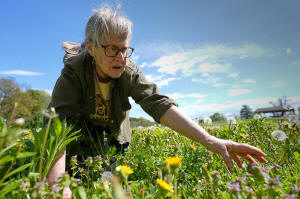Foraging revival: How wild food enthusiasts are reconnecting with nature
[September 25, 2025]
By RODRIQUE NGOWI and KIMBERLEE KRUESI
PORTSMOUTH, N.H. (AP) — Standing barefoot in a grassy patch of
dandelions, Iris Phoebe Weaver excitedly begins listing the many ways
the modest plant can be used medicinally and in cooking.
“I just picked a bunch of dandelion flowers yesterday and threw them in
vodka with some orange peel and some sugar, and that’s my dandelion
aperitif,” Weaver said. “That will make a lovely mixed drink at some
point.”
A longtime herbalist and foraging instructor in Massachusetts, Weaver
takes people on nature walks that transform their relationships with
their surroundings. Lately, she's been encouraged by the uptick in
interest in foraging, a trend she sees as benefiting the environment,
community and people.
“There is just an amazing amount of food that is around us,” Weaver
said. “There is so much abundance that we don’t even understand.”
Humans have been foraging long before they developed the agricultural
tools some 12,000 years ago that quickly overshadowed the ancient act
that helped sustain early humans. Yet foraging enthusiasts say the
search for wild mushrooms, edible plants, shellfish and seaweed has
grown more popular in recent years as people tout their rare finds.
Others share knowledge on social media, and experienced foragers offer
training to novices on safe and sustainable practices.
The renewed interest ranges from those wanting to be budget-conscious —
foraging is free after all — to those wanting to be more mindful of
their environmental footprint. Some even use foraging as a creative
outlet, using mushrooms they find to create spore prints and other art.

The popularity is also helped by the hobby's accessibility. Foragers can
look for wild food everywhere, from urban landscapes to abandoned
farmlands to forests — they just need permission from a private
landowner or to secure the right permit from a state or federal park.
Some advocates have even launched a map highlighting where people can
pick fruits and vegetables for free.
Gina Buelow, a natural resources field specialist with the Iowa
University Extension Program, says the university has had a backlog of
folks eager to learn more about foraging mushrooms for the past two
years. Buelow runs presentations and field guide days throughout the
state, regularly meeting the attendance cap of 30 in both rural and
urban counties.
“Typically, I would get usually older women for a master gardener or
pollinator garden class. That audience still shows up to these mushrooms
programs, but they bring their husbands. And a lot of people between the
ages of 20 and 30 years old are really interested in this topic, as
well,” she said.
[to top of second column]
|

Iris Weaver reaches for a plant while teaching a class on foraging,
May 8, 2025, in Wenham, Mass. (AP Photo/Robert F. Bukaty)
 Some creative chefs are also
sparking interest in foraging as they expose patrons to exotic and
surprisingly tasty ingredients found locally.
“Foraging is an ancient concept,” said Evan Mallett, chef and owner
of the Black Trumpet Bistro in Portsmouth, New Hampshire, a popular
historic New England destination. “Our culture has moved far away
from foraging and is fortunately coming back into it now.”
Mallett opened the restaurant nearly 20 years ago and uses foods
foraged from around Portsmouth. He said he hopes more people will
continue to learn about foraging, and encouraged those worried about
picking something poisonous to find a mentor.
“I think the dangers of foraging are baked into most people’s brains
and souls,” he said. “We as an animal know that there are certain
things that when they smell a certain way or look a certain way,
they can be encoded with a message that we shouldn’t eat those
things.”
Mallett named his restaurant after the wild foraged mushroom as a
reminder. Over the years, he's incorporated Black Trumpet mushrooms
into dozens of dishes throughout the menu — even ice cream.
Other menu items have included foraged sea kelp in lobster tamales,
as well as using Ulva lactuca, a type of sea lettuce, in salads.
“It’s nothing that I necessarily seek out, but I kind of love it
when it’s on a menu,” said M.J. Blanchette, a longtime patron of
Black Trumpet, speaking to the foraged dishes available at Black
Trumpet and other restaurants.
She recently ordered the meatballs with foraged sweet fern from
Mallett's restaurant, a feature she says elevated both the taste and
experience of consuming the dish.
“I think it’s really cool and I think it’s also something that’s not
only foraged, but also tends to be local, and I like that a lot,”
she said.
___
Kruesi reported from Providence, Rhode Island.
All contents © copyright 2025 Associated Press. All rights reserved
 |